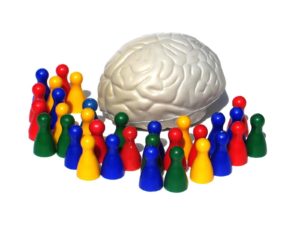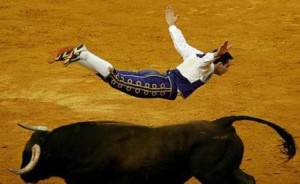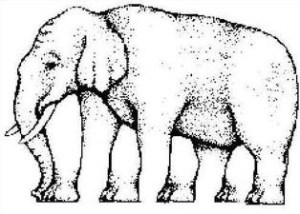 The human brain is a remarkable organ. As anyone who reads my blog knows, I’m a big proponent of playing with it.
The human brain is a remarkable organ. As anyone who reads my blog knows, I’m a big proponent of playing with it.
First of all, it’s a lot of fun. The human brain is inquisitive by nature, and it enjoys finding answers and solving problems. This is especially true with ‘brain teasers,’ questions that are paradoxical or seem to have no logical answer.
There is also a lot of practical application to playing with our brains. Brainteasers challenge us to think and look at things differently. They also force us to see how our entrenched assumptions and beliefs often get in the way of finding answers. With the rate of change in today’s world, learning how to counteract these brain foibles has become a very important leadership skill. When we get stuck in “what is” or “what was” we shut the door on tomorrow – not a good strategy when markets and entire industries can change in the blink of an eye.
Brainteasers also provide a quick and easy way to step away from the stresses and strains of leading a business and just let the mind relax. Allowing the mind to wander is more of a habit than a skill. Developing this habit allows us to take a break from the constant interruptions that disturb our focus and take us off task.
With that in mind, let’s try a few brainteasers and see how good you are at thinking differently.
- Johnny’s mother had three children. The first child was named April. The second child was named May. What was the third child’s name?
- A clerk at a butcher shop stands five feet ten inches tall and wears size 13 sneakers. What does he weigh?
- Before Mt. Everest was discovered, what was the highest mountain in the world?
- How much dirt is there in a hole that measures two feet by three feet by four feet?
- What word in the English language is always spelled incorrectly?
- Billie was born on December 28th, yet her birthday always falls in the summer. How is this possible?
- In British Columbia you cannot take a picture of a man with a wooden leg. Why not?
- If you were running a race and you passed the person in 2nd place, what place would you be in now?
- Which is correct to say, “The yolk of the egg is white” or “The yolk of the egg are white?”
- A farmer has five haystacks in one field and four haystacks in another. How many haystacks would he have if he combined them all in one field?
Answers
- Johnny.
- Meat.
- Mt. Everest. It just wasn’t discovered yet.
- There is no dirt in a hole.
- Incorrectly (except when it is spelled incorrecktly).
- Billie lives in the southern hemisphere.
- You can’t take a picture with a wooden leg. You need a camera (or iPad or cell phone) to take a picture.
- You would be in 2nd place. You passed the person in second place, not first.
- Neither. Egg yolks are yellow.
- One. If he combines all his haystacks, they all become one big stack.
By the way (for those of you who like to sweat the details), if you measure Mauna Kea on the Big Island of Hawaii from its base at the bottom of the ocean, it rises more than 4,000 feet higher than Mt. Everest, making it the tallest mountain on earth.
Evaluating Your Answers
So, how many questions did you answer correctly?
Guess what – it doesn’t matter! The real value of this exercise comes from looking at how you approached answering them. Chances are your answers were affected by some powerful brain idiosyncrasies that strongly influence how we see the world and how we make decisions.
For example, our brains have a strong tendency to see what we want to see and what we expect to see. This has major implications when evaluating customers, markets and competitors. In fact, it influences just about any data we use to make important business decisions.
When we only see what we want or expect to see, we can easily overlook competitive threats. Our brain looks at a potential threat, reviews what it already knows, and tells us a threat couldn’t possibly come from that direction. We miss opportunities because we get stuck in the past rather than imagining what could be. And we miss major market shifts and changes in customer needs that seem obvious in hindsight but can be difficult to spot when focusing on what we already know.
Our brains also love to identify patterns and make connections. This trait serves us well in many ways because it conserves the brain’s energy. The problem here is that the brain often sees patterns and connections that either don’t fit the situation or don’t exist.
For example, how did you answer question #1? Often, the first word that pops into people’s head is “June” because their brain quickly spots the April/May/June pattern. Upon re-reading the question and pausing to analyze the data, the answer becomes obvious.
What about the man with the wooden leg? The answer you come up with depends on how you interpret “with.” Does it refer to the man with the wooden leg or to the camera? A trick question, perhaps. But it illustrates how the way we use language so often shapes how we see the world.
A good example of how we miss things is the egg yolk question. Everybody knows egg yolks are yellow. But the question’s phrasing puts our attention on selecting the correct verb, so we overlook an obvious piece of data and an even more obvious answer.
Why We Need to Think Differently
Here’s a brain teaser I made up: Why are so many companies struggling to keep up (or going out of business altogether) these days?
- Stuck in the past
- Caught up in their own success
- Wearing blinders
- Trapped by their own assumptions
As you probably guessed, the correct answer is “all of the above.”
Market leadership requires agile, nimble ways of working that allow companies to respond quickly and appropriately when their markets do. This requires constantly assessing the business model that has always worked for you to see whether it still aligns with the realities of today’s markets. It means letting go of what made you successful when it no longer works. It means actively seeking out new ideas and perspectives that don’t agree with yours.
Most of all, it means letting go of long-held assumptions and beliefs that lead you to maintain the status quo while your customers and competitors go charging headlong into the future. It’s hard to play catch-up in business, and it’s no fun. That’s why I recommend getting into the habit of playing with your brain. You’ll be amazed at what you end up seeing that you didn’t see before. And your brain gets to enjoy a few well-deserved moments of fun and creative thinking.
Holly guides leaders and their organizations in achieving greater success by teaching you to leverage your brain and the brains of others.
An experienced business leader and behavioral scientist, Holly has a rare combination of extensive academic training and in-the-trenches experience working in and leading organizations. She has also worked with elite performers including the United States Navy SEALs, Top Gun Fighter Pilots, Olympic athletes, senior NFL referees, the FBI Leadership Academy, and two United States Presidents. Holly is the former president of The Ken Blanchard Company, and co-founder of a biotech firm. She has worked in senior leadership roles with global giants including The Coca Cola Company, Dell Computer, Deloitte, and Bass Hotels and Resorts.
Holly holds a Bachelor’s degree in behavioral sciences and a Master of Science degree in organization development. Her postgraduate studies are in neurophysiology. She is a best-selling author of numerous books including More Than a Minute: How to be an Effective Leader & Manager in Today’s Changing World and Using Your Brain to Win.








